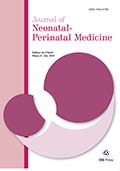Authors: Boskabadi, H. | Beiraghi Toosi, M. | Darabi, A. | Abadi, J.M.T.
Article Type:
Research Article
Abstract:
BACKGROUND: Despite the known effect of hyperbilirubinemia in neonates, the effect of phototherapy on electroencephalography (EEG) remains unknown. Therefore, we aimed to determine the alteration of electroencephalography in infants with hyperbilirubinemia before and after phototherapy. METHODS: This cross-sectional study was performed on infants of≥35 weeks of gestation with hyperbilirubinemia. Information including age, sex, birth weight, hemoglobin levels, and treatment measures was recorded. In all studied infants, an EEG was performed before (in the first eight hours of hospitalization) and after treatment (after phototherapy or blood transfusion). The required duration of phototherapy, hospitalization and adverse effects were assessed then
…EEG of the neonates was compared before and after treatment. RESULTS: A total of 52 infants (44% female and 56% male) were included in this study. Mean gestational age, weight, and bilirubin were 38.6±1.53 weeks, 3150±625 g, and 23.87±4.36 mg/dl, respectively. The most common findings before phototherapy were Frontal Theta (21 patients, 40.4 percent) and Delta Brush (14 patients, 26.9%), while the most common findings after phototherapy were Frontal Theta (20 patients, 38.5%) and Delta Brush (19 patients, 36.5%). Mean±SD of bilirubin in infants with and without Delta Brush was 21.30±1.67 mg/dl and 19.95±0.94 mg/dl, respectively. CONCLUSIONS: Hyperbilirubinemia in newborns may be linked to altered EEG findings. After phototherapy, the Frontal theta was reduced, but the Delta brush was intensified. Bilirubin levels were higher in infants with Delta Brush in their EEG compared to infants without this finding.
Show more
Keywords: Delta brush, electroencephalography, frontal theta, hyperbilirubinemia, neonates, phototherapy
DOI: 10.3233/NPM-221080
Citation: Journal of Neonatal-Perinatal Medicine,
vol. 15, no. 4, pp. 821-825, 2022
Price: EUR 27.50





